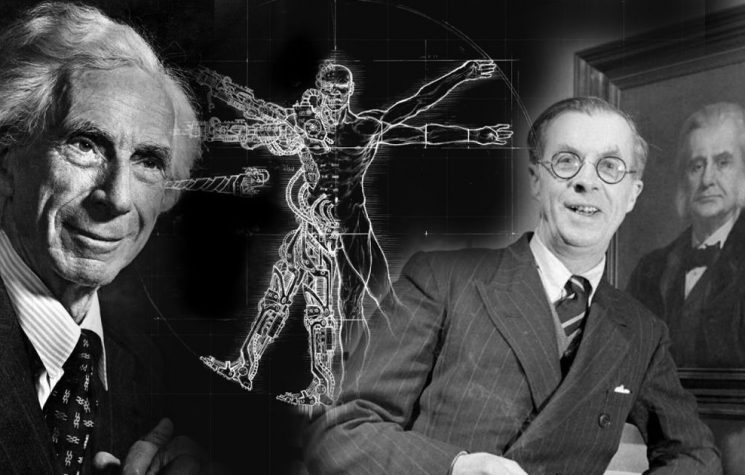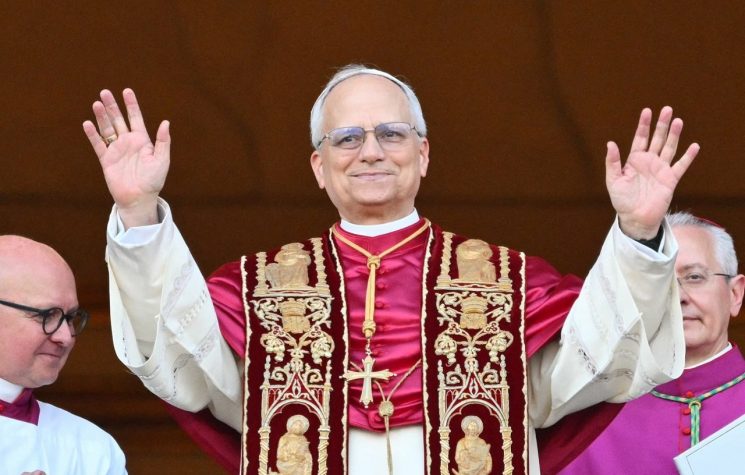The more we are encouraged to think like cold computers, the more the thesis that “computers must replace human thought” could be maintained.
As I outlined in my previous article on the Clash of the Two Systems, the end of the 19th century saw a major clash between two opposing paradigms of political economy which has largely been scrubbed out of history books.
Just like today, the two opposing systems were characterized on the one hand, by a demand for centralized control of the world by a unipolar elite yearning to stand above the influence of sovereign nation states like modern gods of Olympus, while the other was premised on a “multipolar” design of a community of sovereign nation states working together on large scale infrastructure and technological progress. One was premised on closed system Malthusian economic standards of adapting to diminishing returns while the other was founded upon standards of ongoing scientific progress generating creative leaps out of the constraints of limited resource baskets.
Today I would like to continue to trace the roots of those poisonous ideas which characterize today’s unipolar paradigm which masquerades behind a billionaire-authored “Great Reset” of world civilization. In this reset, we are told by the likes of Klaus Schwab that a “Fourth Industrial Revolution” will usher in not only vast automation and Artificial Intelligence operations at every level of society, but also a merging of humanity with machines. Figures like Elon Musk and Google’s Ray Kurzweil assert this merging is needed in order to “stay relevant” in the next phase of our evolution. Davos-man Yuval Harari echoed that the levers of evolution will now be moved from the randomness of nature into the new gods running Google, Facebook and the WEF.
This Borg-like deterministic faith in the human-machine synthesis that pervades the thinking of all modern transhumanists is both cultish, creepy and just plain wrong. However, without a proper evaluation into the historic roots of these ideas that threaten to derail global civilization into a dystopian collapse, it is impossible to understand anything fundamental about the past 120 years of human experience, let alone see where the fatal flaws are within the Great Reset/Transhumanist operating system.
In part one of our series, we explored the eugenics-roots of transhumanism in some detail with a focus on Julian Huxley’s creation of UNESCO where the mandate to “make the unthinkable become thinkable” guided the restoration of a new eugenics during the Cold War.
In part two, we explored the rise of a new array of 19th century British think tanks designed to disrupt the natural evolution of a new system of win-win cooperation during the end of the 19th century. This new grand design was innovated by Thomas Huxley’s X Club in order to re-establish the British Empire as the only unipolar power on the earth. Huxley’s design attempted to not only unify all branches of sciences under one descriptive model devoid of any actual creative discovery, but also attempted to use this new control of the definition of “scientific natural law” to justify an aggressive new imposition of imperial political economy onto the world.
The Dance of Math and Physics: Who Leads and Who Follows?
In the opening months of the new century, a major event took place that went far to apply Huxley’s mission. The Future of Mathematics Conference of August 1900 was a global event attracting over 160 of the greatest mathematicians who wished to tackle cutting edge problems in science and deal with the relationship of physics and mathematics. Obviously, these two fields danced together, but the question remained: which would lead and which would follow?
Considering the fact that the world population still numbered well below two billion at this time, the density of scientific discoveries across all domains was occurring at a rate unseen in human history. From new discoveries in biology, embryology, atomic physics, electromagnetism, aerodynamics and chemistry, the answer to the math vs physics question was increasingly becoming obvious. The fact was that the growth of human knowledge was fast outpacing the limits of the mathematical language used by scientists. With time, new mathematical systems would be developed to describe the new creative discoveries being made, but no one could deny that creative thought was leading in this dance. What was also undeniable was the dramatic benefit that new ideas had to improve the conditions of countless lives through leaps in scientific and technological progress.
Hilbert and Russell Shape a New Paradigm
Two particularly important figures who played leading roles in sabotaging science during the 1900 Paris Conference and whose ideas are inextricably linked to the later evolution of eugenics, cybernetics and transhumanism were Cambridge Apostle Lord Bertrand Russell and Gottingen mathematician David Hilbert.

The duo aimed at nothing less than the reduction of the entire universe into a series of finite, internally consistent mathematical propositions and axioms.
During the 1900 conference, Hilbert announced his 23 problems for mathematics that would need to be solved by mathematicians of the 20th century. While many of these problems were genuinely important, the most destructive for the purpose of this article centered around the need to “prove that all axioms of arithmetic are consistent” [problem 2] and “axiomatize those physical sciences in which mathematics plays an important role” [problem 6].
It took 13 years for Russell to achieve this objective in the form of his Principia Mathematica (co-authored with his former instructor and fellow Cambridge Apostle Alfred North Whitehead).

The name “Principia Mathematica” was chosen explicitly as an homage to Newton’s “Principia Mathematica” published 200 years earlier. At the time of the 1900 launch of the Russell-Hilbert project, both Euclid and Newton’s flat interpretations of physical space time were quickly crumbling with the advent of new discoveries by Riemann, Curie, Weber, Planck and Einstein who were all demonstrating that the shape of physical space time had a living, creative character. With each creative discovery, a reciprocal interconnectedness between the “subjective” inner space of human cognition and the “objective” outer space of the discoverable universe was ever more firmly established.
Exemplifying this beautiful insight and passion to seek the unknown which was common among great scientists during this fertile revolutionary period, Einstein stated: “I want to know how God created this world. I am not interested in this or that phenomenon, in the spectrum of this or that element. I want to know His thoughts; the rest are details”.
Reflecting this same view in his own way, Max Planck stated “Science enhances the moral value of life, because it furthers a love of truth and reverence—love of truth displaying itself in the constant endeavor to arrive at a more exact knowledge of the world of mind and matter around us, and reverence, because every advance in knowledge brings us face to face with the mystery of our own being.”

Closed System Entropy Must Define the Universe!
Russell’s closed system entropic mathematics was a direct reflection of his misanthropic view of an entropy-destined humanity which can explicitly be seen in his 1903 statement:
“That man is the product of causes that had no prevision of the end they were achieving; that his origin, his growth, his hopes and fears, his loves and his beliefs, are but the outcome of accidental collocations of atoms; that no fire, no heroism, no intensity of thought and feeling, can preserve individual life beyond the grave; that all the labors of the ages, all the devotion, all the inspiration, all the noonday brightness of human genius, are destined to extinction in the vast death of the solar system, and that the whole temple of Man’s achievement must inevitably be buried beneath the debris of a universe in ruins- all these things, if not quite beyond dispute, are yet so nearly certain that no philosophy which rejects them can hope to stand… Only within the scaffolding of these truths, only on the firm foundation of unyielding despair, can the soul’s habitation henceforth be safely built.”
When pondering which set of metaphysical views has greater claim to truth featured above, it is worth asking the question: Who actually made demonstrable discoveries into creation and who merely formulated ivory tower models devoid of any actual element of discovery?
Part of the formula for success in Russell’s mind hinged on his obsession with mathematical equilibrium in all things. When applied to society, it was no wonder that Russell was a devout Malthusian and life long promoter of eugenics and population control. One of his many displays of this disgusting view was made in his 1923 Prospects of Industrial Civilization where the social engineer stated:
“Socialism, especially international socialism, is only possible as a stable system if the population is stationary or nearly so. A slow increase might be coped with by improvements in agricultural methods, but a rapid increase must in the end reduce the whole population to penury… the white population of the world will soon cease to increase. The Asiatic races will be longer, and the negroes still longer, before their birth rate falls sufficiently to make their numbers stable without help of war and pestilence… Until that happens the benefits aimed at by socialism can only be partially realized and the less prolific races will have to defend themselves against the more prolific by methods which are disgusting even if they are necessary.”
Russell’s later writings in The Scientific Outlook (1930) extend his views of a stationary global society onto educational reform where he defines the need to have not one, but two separate modes of education: one for the elite master class who will become rulers and one for the inferior slave class. Russell outlines the two castes in the following cold-blooded terms:
“The scientific rulers will provide one kind of education for ordinary men and women, and another for those who are to become holders of scientific power. Ordinary men and women will be expected to be docile, industrious, punctual, thoughtless, and contented. Of these qualities probably contentment will be considered the most important. In order to produce it, all the researchers of psycho-analysis, behaviourism, and biochemistry will be brought into play…. All the boys and girls will learn from an early age to be what is called `co-operative,’ i.e., to do exactly what everybody is doing. Initiative will be discouraged in these children, and insubordination, without being punished, will be scientifically trained out of them.”
For the ruling class: “Except for the one matter of loyalty to the world State and to their own order,” Russell explained, “members of the governing class will be encouraged to be adventurous and full of initiative. It will be recognized that it is their business to improve scientific technique, and to keep the manual workers contented by means of continual new amusements.”
All of Russell’s later writings promoting pre-emptive nuclear bombings of Russia, World Government run by a scientific dictatorship and teaching children to believe that “snow is black” must be read with his racist philosophical worldview in mind.
Norbert Wiener and the Rise of Cybernetics
In 1913, as Russell’s third and final volume of the Principia Mathematica was being printed, a young mathematics protégé arrived at Cambridge from the USA on a scholarship. This teenager’s name was Norbert Wiener and he soon found himself among a small group of boys closely mentored by Bertrand Russell and David Hilbert. Under Russell, Wiener was taught logic and philosophy while Hilbert taught him differential equations. Speaking of Russell, Wiener said: “when I came to study under Bertrand Russell in England, I learned that I had missed almost every issue of true philosophical significance”. He called Hilbert “the one really universal genius of mathematics”.

Throughout his entire life, Wiener was possessed by the obsession to express Russell’s logical closed system in practical ways.
Despite the fact that a young Leibnizian genius named Kurt Gödel threw a major wrench into Russell’s Principia program through his brilliant 1931 demonstration that no logical system could ever be truly consistent with itself due to the self-reflexive nature of all existent systems, Russell pushed forward with the project full force and Wiener was Russell’s leading apostle.
Other Russellites whose theories of machine learning included such names as Alan Turing, Oskar Morgenstern, Claude Shannon and John von Neumann. While each mathematician had their own particular innovation to offer, they were all united by the unwavering faith that a human mind was a mixture of bestial impulses guided by closed-system machine logic and nothing more. In a computer, the whole is but the sum of parts, and so too must it be in all information systems including human brains, ecosystems and the universe as a whole. “Metaphysical” principles like soul, purpose, God, justice and free will had no place in the minds of these human calculators.

By the end of WW2, Wiener’s work on feedback loops in aeronautics and radar led the mathematician to devise a new language for managing complex human systems which he soon discovered had application in business, military affairs and entire nations. The term he gave this new tool of control was “cybernetics”. Describing his invention, Weiner stated:
“Cybernetics, which I derived from the Greek word Kubernetes, or steersman, the same Greek word from which we eventually derive our word governor”.
By relying on binary closed system computer machines as his model for human minds, Weiner demanded that metaphysical concepts be assumed to have no existence beyond the merely physical characteristics of the measurable electrochemical properties of the brain. Describing this computer- mind analog, Weiner stated: “It became clear to us that the ultra rapid computing machine, depending as it does on consecutive switching devices must represent almost an ideal model of the problems arising in the nervous system” and that “the problem of interpreting the nature and varieties of memory in the animal has its parallel in the problem of constructing artificial memories for the machine.”
Cybernetics for Global Governance
Forecasting the inevitability of systems of global information control (and thus total political control by a god like governing class) as well as artificial intelligence, Weiner wrote: “where a man’s word goes and where his power of perception goes, to that point his control and in a sense his physical existence is extended. To see and to give commands to the whole world is almost the same as being everywhere.”
The key to understanding the attraction of cybernetics to a scientific dictatorship desirous of total omniscience and omnipotence is the following: In the context of a large boat, only the helmsman need have an idea of the whole. Everyone else need only understand their local compartmentalized role.
With the application of cybernetics to the organization of economic systems (as carried forth by the Organization for Economic Cooperation and Developments’ Sir Alexander King and applied across governments of the trans Atlantic during the 1960s and 1970s), vast complex bureaucracies emerged with only small nodes of “helmsmen” embedded within the newly emerging deep state complex who had access to a vision of the whole. This was the perfect operating system for a supranational technocracy to use to control the levers of the New World Order.
One of the most enthusiastic practitioners of this new system during this period of transformation was Pierre Elliot Trudeau (the newly imposed Prime Minister of Canada) who shaped a vast cybernetics revolution of the Canadian government between 1968-1972 under the control of the Privy Council Office. During a November 1969 conference on Cybernetics in Government, Trudeau said: “We are aware that the many techniques of cybernetics, by transforming the control function and the manipulation of information, will transform our whole society. With this knowledge, we are wide awake, alert, capable of action; no longer are we blind, inert powers of fate.”
Trudeau worked closely with Sir Alexander King in the formation of a new organization that had a profound impact on global governance from 1968-present called the Club of Rome. Trudeau was a devout supporter of this new organization which became a center of neo-Malthusian revivalism during the early year 1970s. Trudeau even presided over the Canadian Club of Rome and allocated money to fund the MIT Club of Rome study “Limits to Growth” that became a bible for the modern environmental organization.

Alexander King and the computer model made famous in the 1972 Limits to Growth that imposed a new schism between humanity’s desire to develop vs nature’s supposed desire to rest in mathematical equilibrium
Unlike Russell who denied all cases of anti-entropy, Weiner allowed for the existence of isolated islands of limited anti-entropy in the case of biology and human systems which tended to operate in ways that saw entropy (aka: the tendency of systems to collapse into equilibrium) decrease. However just like Russell, Wiener believed that cybernetics and information theory were shaped entirely by entropy, saying:
“The notion of the amount of information attaches itself very naturally to a classical notion in statistical mechanics: that of entropy.” [aka: the second law of thermodynamics]
In Wiener’s mind, the dominant law of the universe as a decaying finite place shaped by death which would inevitably destroy the limited states of anti-entropic life which occurred purely by chance in random parts of “space” and in “time” saying in 1954:
“it is highly probable that the whole universe around us will die the heat death, in which the world shall be reduced to one vast temperature equilibrium in which nothing really new ever happens. There will be nothing left but a drab uniformity.”

The Macy Conferences on Cybernetics
From 1943 until 1953, Wiener’s cybernetics and his information theory corollary became the rallying point for a new scientific priesthood that would gather together leading thinkers of every branch of knowledge in the same effort that was previously made under the 19th century helmsman Thomas Huxley and his Royal Society X Club.
These conferences were funded by the Josiah Macy Foundation which had been created by General Marlborough Churchill (a cousin of Winston Churchill) in 1930 with the primary aim of conduiting funds towards eugenics research in both the USA, and Germany alongside its sister organization called The Rockefeller Foundation. The later operation would fund leading Nazi eugenicist Ernst Rudin from 1928 throughout the entire 1930s while sponsoring research led by the British and American eugenics societies.
As Anton Chaitkin points out in his British Psychiatry from Eugenics to Assassination, the Macy Foundation’s founder and controller Gen. Marlborough had formerly headed the military intelligence’s Black Chamber from 1919 until its disbanding in 1929. The Black Chamber interfaced closely with British Intelligence and served as the predecessor to what later became the National Security Agency (NSA).
Starting in 1945 and desperately in need to prevent the spread of the American System of Political Economy and an international New Deal that had been put into motion by anti-imperial president Franklin D. Roosevelt, the Macy Conferences on Cybernetics began meeting every six months bringing together Tavistock-connected psychiatrists, biologists, neurologists, computer engineers, sociologists, economists, mathematicians, and even theologians. Wiener described these conferences which shaped the course of the next 75 years saying “for human organization, we sought the help from the anthropologists Doctors [Gregory] Bateson and Margaret Mead while Dr. [Oskar] Morgenstern of the Institute of Advanced Study was our advisor in the significant field of social organization belonging to economic theory…Dr [Kurt] Lewin represented the newer work on the opinion of opinion sampling and the practice of opinion making”.
Social Engineering Drives the Post-War Order
For those who may not know, Dr. Bateson was a leading controller of the CIA’s MK Ultra program which ran from 1952-1973 as a multi billion-dollar covert operation designed to study the effects of depatterning both individuals and groups using mixtures of electroshock therapy, torture and drugs. Oskar Morgenstern was the innovator of “Game Theory” which played a dominant role in both military planning of the Vietnam War as well as economic systems for the next 70 years. Dr. Kurt Lewin was a leading psychiatrist from London’s Tavistock Clinic and member of the Frankfurt School that organized a concerted program to eliminate the sickness of national patriotism, belief in truth, and family love throughout the Cold War period.
A prominent conference member and planner of this operation was named Sir Julian Huxley- a leading eugenicist and imperial grand strategist who worked closely with fellow Fabian Society leader Bertrand Russell. Huxley shared Russell and Wiener’s devout belief in universal entropy saying in 1953:
“Nowhere in all its vast extant is there any trace of purpose, or even of prospective significance It is impelled from behind by blind physical forces, a gigantic jazz dance of particles and radiations in which the only over-all tendency we have so far been able to detect is that summarized in the second law of thermodynamics- the tendency to run down.”

As he was beginning to formulate his concept of “transhumanism” and while he was organizing the Macy Cybernetics Conferences, Julian found the time to create the United Nations Education Science and Cultural Organization (UNESCO) in 1946 drafting its founding manifesto. His entropic view of biology and physics was clearly expressed in his bone chilling political views wherein he writes:
“The moral for UNESCO is clear. The task laid upon it of promoting peace and security can never be wholly realised through the means assigned to it- education, science and culture. It must envisage some form of world political unity, whether through a single world government or otherwise, as the only certain means of avoiding war… in its educational programme it can stress the ultimate need for a world political unity and familiarize all peoples with the implications of the transfer of full sovereignty from separate nations to a world organization.”
Working in tandem with the World Health Organization- itself created by a Tavistock psychiatrist named G. Brock Chrisholm, and funded entirely by the Macy Foundation, Huxley organized the creation of the World Federation of Mental Health (WFMH) overseen by the Bank of England’s Montagu Norman and directed by the head of London’s Tavistock Clinic Maj. General John Rawlings Rees- whom Montagu directly appointed.
Chaitkin points out that among the first projects which the WFMH and Macy Foundation jointly organized were the “Conferences on Problems of Health and Human Relations in Germany” in 1949-1950 which ensured that the Frankfurt School’s Authoritarian Personality thesis was drilled into the minds of all German children. The goal was to persuade the German people that the whole fault of Hitler’s rise to power was not to be found in looking for international conspiracies or City of London/Wall Street manipulation… but rather in the “authoritarian psychological-genetic” disposition of the German people themselves. This program was overseen by Tavistock Director Kurt Lewin, who by this time became a leading figure of the Frankfurt School and innovator of a new brainwashing technique called “sensitivity training” which relied heavily on the use of guilt complexes and group pressure to break the will of a target group either in a classroom or in the workplace and absorbing any original thinkers into states of group think. Lewin’s work with the WFMH and Tavistock also became the foundation for today’s Critical Theory doctrines that threaten to undermine the entire scope of western civilization.
To the degree that individuals think for themselves and are inner directed by factors of 1) creative reason and 2) conscience, the group-think systems no longer behave according to the sort of statistically predictable rules of entropy and equilibrium which control-hungry oligarchs and technocrats demand. Erasing that factor of “unpredictability” by making the argument that all leaders who profess truth are simply “authoritarian personalities” and “new Hitler-types”, the virtue of mobs was raised above the virtue of individual genius and initiative which continues to plague the world to this day. (1)
Cybernetics Conferences evolved throughout the 1960s-1970s finding themselves increasingly integrated with international organizations like the United Nations, World Health Organization, NATO, and OECD. As this integration occurred, the new technocrats became ever more influential in setting the standards of the new world operating system. Meanwhile national governments found themselves increasingly cleansed of nationalist moral leaders like John F. Kennedy, Charles DeGaulle, Enrico Mattei, and John Diefenbaker resulting in the integration of systems analysis and cybernetics into the governing framework of the new international deep state.
While Julian Huxley coined the term “transhumanism” in 1957, the cult of Artificial Intelligence guided by a belief in the inevitable merger of man and machine grew increasingly with such major events as the man-computer symbiosis thesis of J.C.R Licklider of 1960 and the application of these systems into Department of Defense programs like wargames command systems, SAGE (Semi Automatic Ground Environment), and unmanned jet plane defense networks. DARPA’s Augmented Cognition Computer-Soldier dyads were yet another expression of this perverse idea with hundreds of millions of dollars spent on the creation of enhanced cyborg soldiers.
Over the years, followers of this new cult soon found themselves operating as helmsmen in the new global ship of earth giving rise to a new global elite class of technocrats and oligarchs loyal only to their caste and ideology, striving to shape their minds ever more closely to the model of idea computing machines capable of logic, but not love or creativity. The more that these cultish technocrats like Yuval Harari, Ray Kurzweil, Bill Gates or Klaus Schwab could think like cold computers, while getting the masses of the earth to do the same, the more the thesis that “computers must obviously replace human thought” could be maintained.

























